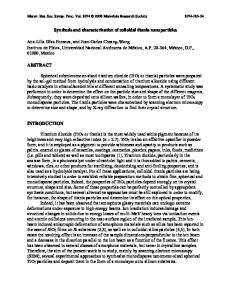Synthesis and Characterization of Cassava Bark Nanoparticles
- PDF / 1,938,690 Bytes
- 8 Pages / 432 x 648 pts Page_size
- 72 Downloads / 428 Views
MRS Advances © 2018 Materials Research Society DOI: 10.1557/adv.2018.412
Synthesis and Characterization of Cassava Bark Nanoparticles F.O. Kolawolea,b,*, S.K. Kolawolec, J.O. Agunsoye b, S.A. Bellob,d, J.A. Adebisib,e, W.O. Soboyejof, S.B. Hassanb a
Department of Materials and Metallurgical Engineering, Federal University, Oye-Ekiti, Nigeria
b
Department of Metallurgical and Materials Engineering, University of Lagos, Lagos, Nigeria
c
National Agency for Science and Engineering Infrastructure, Abuja, Nigeria
d
Department of Materials Science and Engineering, Kwara State University, Malete, Nigeria
e
f
Department of Metallurgical and Materials Engineering, University of Ilorin, Ilorin Nigeria
Department of Mechanical and Aerospace Engineering, Princeton University, New Jersey, U.S.
Corresponding Author: [email protected] or [email protected]
Abstract
Synthesis and characterization of cassava bark nanoparticles (CBNPs) was carried out using ball milling at 36, 48, 60 and 72 hours. The morphology study was done using SEM and the Gwyddion software was used to determine the particle sizes from the SEM images. The particle distribution for the un-milled cassava bark (CB) was between 1.25 + 0.06 to 19.92 + 1.00 µm, while after milling for 36, 48, 60 and 72 hours the average particle size were 4.07 + 0.20, 4.00 + 0.20 µm, 80.90 + 4.05, 74.50 + 3.73 nm respectively. 13.68 + 0.68 nm was obtained by XRD using Scherrer equation after milling for 72 hours and the XRD results revealed the presence of compounds such as SiO2, CaCO3 and KAlSi3O8. TEM was used to determine nanoparticle size distribution after milling for 72 hours and the particle size ranged from 9.73 + 0.49 to 114.60 + 5.73 nm for cassava bark nanoparticles (CBNPs), EDX results showed trace element of Si, Ca, K, Fe, Al, O in the CB milled for 72hours.
Downloaded from https://www.cambridge.org/core. University of Pennsylvania Libraries, on 15 May 2018 at 10:53:30, subject to the Cambridge Core terms of use, available at https://www.cambridge.org/core/terms. https://doi.org/10.1557/adv.2018.412
INTRODUCTION Agro-wastes which are dumped all over the environment and serves as nuisance are beginning to gain attention in different areas of application including composite, biogas, animal feed, bio-fertilizer [1-5]. The use of agro-waste for different applications helps to add value to waste materials and replace other items where cost and availability is considered [4-5]. It also provides cleanliness to our environment. The botanical name for Cassava is Manihot esculenta, it is a woody shrub of the spurge family, Euphorbiaceae from South America. It is commonly cultivated annually in the tropical and sub-tropical regions for its edible starchy tuberous root (carbohydrate source) [6]. World production of cassava root was estimated to be 245 million tonnes in 2012, while production in Africa was about 137 million tonnes, being the largest contributor to the world production; 75 million tonnes was produced from Asia and 33 million tonnes from
Data Loading...











